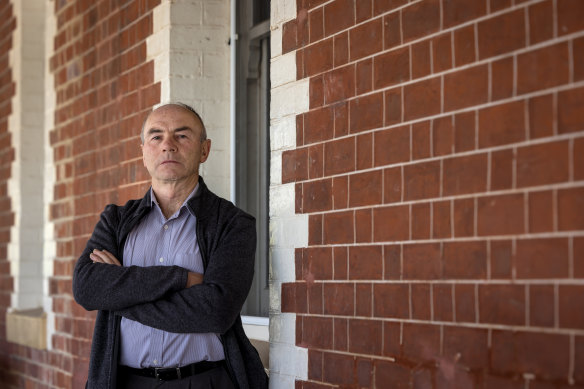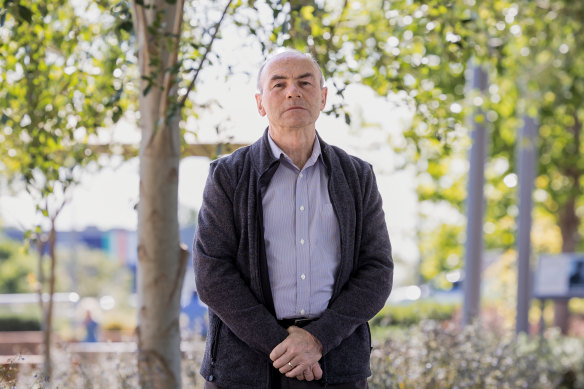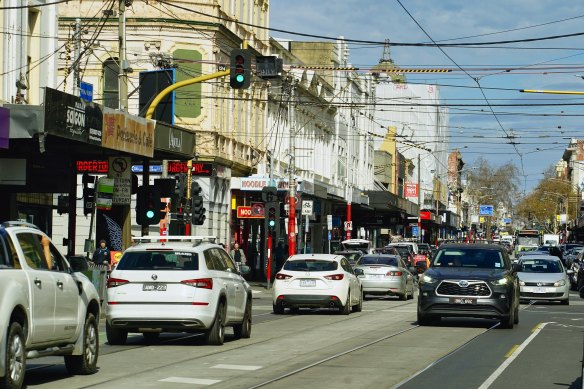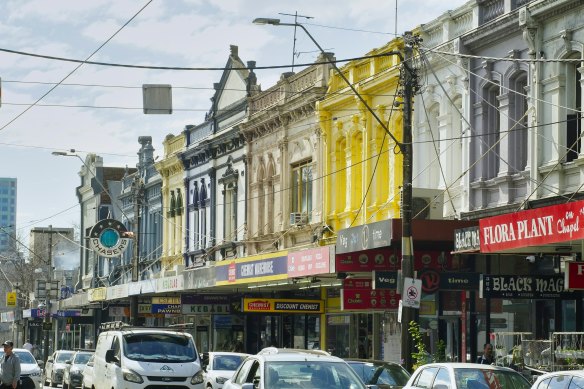This was published 9 months ago
The Melbourne neighbourhood where one in three units sells at a loss
By Elizabeth Redman and Brittany Busch
Richard Swanson faced a tough choice: sell the South Yarra investment property he had owned for six years for a loss, or hold on and hope it recovered in value.
He chose to hold. That was five years ago and since then prices have only fallen further. After about 11 years, he has just sold the apartment for $156,000 less than he paid.

Richard Swanson sold an investment property at a loss. Credit: Jason Robins
This is the puzzle at the heart of Melbourne’s housing affordability crisis: property prices have soared over the long term, but not for all properties. There aren’t enough homes, but there are too many of the wrong type of home. Young families have increasingly been locked out of home ownership, but there are few willing buyers for well-located, entry-priced apartments.
The Victorian government this week unveiled fresh plans to increase housing density in areas close to transport and amenities, along with a range of proposals to unlock land in the outer suburbs, speed up subdivisions and offer relief on stamp duty to address affordability.
Of the 25 new activity centres, eight are in the City of Stonnington, one of the most desirable areas to live in Melbourne.
And yet, that puzzle: of the homes that sold in Stonnington in the June quarter, 25.8 per cent traded at a loss, figures from research firm CoreLogic show. Stonnington runs second to the Melbourne City Council area, where 39 per cent lost money.
Split by property type, 32.4 per cent of Stonnington apartments that sold in the June quarter lost money. Only 2.1 per cent of houses met the same fate.
Since nearly one in three apartment sellers in Stonnington are losing money, stories like Swanson’s are not unusual, even if many owners are reluctant to speak publicly.
The Beechworth-based public servant, 63, and his wife bought their two-bedroom apartment off the plan about 11 years ago for $691,000. They will settle to the new buyer on Monday for $535,000.
Taking into account holding costs, he estimates conservatively they have lost $200,000.

Richard Swanson had a lovely apartment, but many others were built nearby.Credit: Jason Robins
The property is near South Yarra train station, where a cluster of high-density apartment blocks have been built. It was rented out but the tenant relocated after the COVID-19 pandemic hit. Then the apartment was competing for tenants with its similar neighbours.
Once interest rates jumped, the rent no longer covered the mortgage repayments. Then the Victorian government increased land tax on second home owners.
“It’s a lovely apartment in a lovely complex where we are in South Yarra but what we weren’t aware of is at the same time, there was a lot of other developers who were also building lots of apartments,” Swanson said.
“I think the apartment market is overcrowded. I know there’s a lot of people needing rental accommodation … it’s a catch-22 in a way.”
He sold through Woodards South Yarra, which handles sales of a mix of properties, from apartment towers and art deco unit blocks to multimillion-dollar houses. Director Luke Piccolo says large two-bedroom boutique apartments can cost close to $2 million.
There are much more affordable options in the Forest Hill precinct near the train station, where some towers have had cladding issues, water issues, or lesser-quality builds.
Buyers could associate some of these homes with uncertainty and risk if they had heard they might have to pay for cladding repair or they might face a drop in value, Piccolo said.
“Some first home buyers have bought a one-bedroom apartment for $450,000 to $500,000 and it’s now worth in the high $300,000s or $350,000,” he said.
“Losing $100,000 on your first purchase sets people back a long way, a very long way.”
Piccolo welcomes the idea of more apartments in well-located areas near transport and infrastructure but fears they will not match the demand from young family buyers who would better suit a three-bedroom apartment, a townhouse or a house.
He said apartment demand had been soft lately.
“The owner-occupiers who are the vast majority of the buyers are cautious about buying apartments and cautious about the price they’re paying whereas anything that has its own block of land and has a backyard and is fit for a family, the demand is incredibly high.”

The City of Stonnington is among the most desirable areas to live in Melbourne.Credit: Luis Enrique Ascui
CoreLogic head of Australian research Eliza Owen has been tracking loss-making sales for years. She points out that during the 2010s, there was a building boom financed by investor buyers who could access lower interest rates and long interest-only periods, which have now mostly dried up.
Owen said developers looking to start projects now would need pre-commitments to get finance – perhaps the stamp duty concession would help – and would be likely to bring new supply of units to market only if prices rise.
This is the conundrum. The plan was to increase supply of units so the value of homes came down, but for that supply to be feasible, the value of homes would need to go up, Owen said.
She said existing investor-grade apartment towers were built for a type of investor buyer that was now less common.
“The buyer pool can shift easily, the urban landscape can’t,” Owen said.
“It’s really important that the stock that is developed under these policies do have lasting buyer demand if they’re going to have feasibility from developers and if they’re going to have take-up from buyers.”
Unit returns had generally been lower than houses, and had a higher incidence of loss, she said.
“That’s a generational shift we need to be prepared for. It’s very unlikely this generation of owners shifting to the apartment sector out of necessity are going to be making the same windfall gains as previous generations who were more concentrated in the detached house segment,” she said.
She warned developers might have to work hard to show the quality of their product after past high-profile flammable cladding issues.
South Yarra’s median unit value is about $618,000, 9.6 per cent lower than its high in November 2021, and still 2 per cent lower than five years ago, CoreLogic found. Armadale’s median unit value is 12.4 per cent below its April 2018 peak.
Residential property expert Angie Zigomanis said the financial viability challenge – rather than zoning – was the reason there wasn’t more new apartment development happening now.
For example, the South Yarra station area had a ramp-up in new supply focused on investor buyers. Now the market was favouring owner-occupiers and there was less demand for that stock, the head of data and insights at Quantify Strategic Insights said.
“If you need to be achieving a certain price to be able to develop it, and purchasers have options in the same suburb that are a lower price … where is the incentive to pay the brand new price?”
That might change in a few years if pricing catches up. But in the short term, Zigomanis believes new development would be largely boutique projects and townhouses.
He agreed prices would need to rise to underwrite new towers, and thought stamp duty relief might help a little. But if more apartments were built that would restrict capital growth, he said.
Thomson Real Estate director John Chartres welcomes new apartments near train lines and shops. But when he heard about the government plans for new units, he thought: “Who’s going to buy them?”

The Victorian government wants more homes in well-located areas.Credit: Luis Enrique Ascui
“We’re selling a lot of investor stock at the moment because of the government’s taxes,” he said. “We’re trying to find the owner-occupiers to buy the apartments, and they’re mainly first home buyers but we’re struggling.”
He said first home buyers were selective and wanted a courtyard or balcony with a nice outlook in a secure building.
But many investor-grade apartments for sale don’t have balconies, some have borrowed light in the bedrooms, some have car stackers, and if they are smaller than 40 square metres, first home buyers may not be able to get a home loan.
Xynergy Realty chairman Bruce Oliver has seen investors selling out of high-rise developments given their higher land tax.
“The capital gain is not that great when it comes to high-rise buildings,” he said. “There are too many units available in one building … if they tried to resell within the first five years, it’s most likely they lose their money.
“But if they buy a boutique apartment, it’s better, and depending on which development they buy, they probably could make money.”
Biggin Scott director Michael Tynan said apartment buyers had shifted from investors to first home buyers, as renters discovered it could be cheaper to buy.
“If you look at South Yarra, Yarra Street, Claremont Street, that little pocket there, there’s a lot that’s available. Haven’t been selling, just sitting there on the market,” he said.
Tynan said smaller dwellings were more likely to lose money.
“For the newer style apartments, the more cookie-cutter apartments, there hasn’t been any growth, or it’s actually gone backwards. For the older style apartments in the bigger blocks, there has been a little bit of growth, but not as much as you’d be hoping for,” he said.
As for investor Richard Swanson, he also owns a Queensland apartment. Asked if he would invest in a Melbourne apartment again, he is blunt.
“No, never,” he said. “There is no incentive to own more than one property in Victoria.”
The apartment was supposed to be part of their retirement plans. Instead, it cost $200,000.
“It has just been a nightmare. I just want to put it behind me,” Swanson said.
Start the day with a summary of the day’s most important and interesting stories, analysis and insights. Sign up for our Morning Edition newsletter.